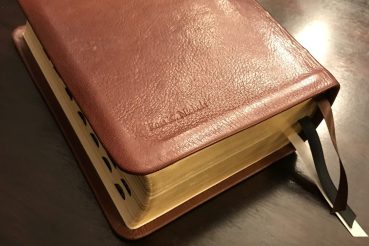I am often asked about the best English translation of the Hebrew Bible. I prefer the The Jerusalem Bible Edition of the Koren Tanakh for several reasons and intend to share some of those reasons in this post.
The introduction to the Koren Tanakh proudly refers to this work as the “First Jewish Bible in Over 450 years” (p. xiii). This claim is supported thusly, “During the decade of the 1950s, Eliyahu Koren, with Meir Medan, led a team including Dr. Daniel Goldschmidt and Avraham Meir Haberman, to create a critical edition based on Masoretic sources. The Koren Tanakh was the first fully Jewish Tanakh to be published since the end of the fifteenth century, with Jewish scholars and editors, type designers, printers and binders” (p.xiv).
The Koren Tanakh was originally translated into English in 1967. The original work was based upon several other English translations accepted for Jewish use in the English-speaking world. The principle work was based on The Jewish Family Bible of M. Friedländer, published in 1881. The late Professor Harold Fisch, a scholar of English literature and the Rector of Bar Ilan University, was responsible for the final edited version. Professor Fisch took the base text supplied by Friedländer, compared it with the Isaac Lesser version and other translations, and incorporated insights from modern scholarship and Jewish sources to produce the finished product. Where possible and necessary, Fisch updated archaic language, but at the same time, he maintained elements that many modern translations eliminated. One such example was his use of second-person pronouns. Using “you” for both singular and plural leaves the reader wondering what the Hebrew says and can cause unnecessary confusion. In the Koren Tanakh, when the reader sees “you or your,” it represents the plural, but when the reader encounters “thou, thee, thy, or thine,” the singular is intended. Although not always understood by modern readers, when thou is used, it represents the subject of the sentence; when thee is used, it represents the object of the sentence. Thy and thine represent the possessive of you, i.e., “your.” The Koren Tanakh does away with the archaic ye, so the plural, which it was intended to represent, has been simply rendered you. So retaining the older forms for the singular and using “you” for the plural allows the reader to see what is intended by the Hebrew behind the English translation.
Several special features in The Jerusalem Bible Edition of the Koren Tanakh set this Hebrew Bible apart from other English translations. The Books are arranged according to the order found in the Hebrew Bible rather than the way they appear in non-Jewish Bibles. The Bible is in Hebrew and English and is arranged from right to left, following the Hebrew text. The English translation appears on the left-hand page, while the corresponding Hebrew, upon which the translation is based, appears on the right-hand page. Students of Hebrew will find this helpful as one can easily look to the Hebrew to check the accuracy and literalness of the English in any given word or verse. While the Koren uses the universally accepted chapter and verse divisions, first introduced into Jewish Bibles by Christians, it also employs Masoretic divisions such as open line breaks and closed spaces present in the Hebrew as well as the English. The names of people and places are closely transliterated from the Hebrew (i.e., Moses is Moshe in Koren), yielding a more original and authentically Hebrew translation. The annual readings of the Torah are marked in the text of the Torah, and the prophet readings assigned to each Torah reading are recorded in an appendix. Also in this section, one will find other helpful references. These include the “Ten Commandments” as they appear in Exodus and Deuteronomy, a list of textual variants, Torah Readings for special days, Blessings before and after reading the Torah and Haftara, cantillation notes, an index of all names in the Tanakh in alphabetic order, 27 maps are included in a Bible Atlas, and genealogy charts for the patriarchs and matriarchs and for the sons of Israel.
The Jerusalem Bible Edition of the Koren Tanakh is the Bible that I prefer. The only drawback for some is its size and shape. The Bible weighs about 3 pounds and is 5.8 x 2.9 x 8.3 inches, making it thick for its width and height dimensions. This is due to the inclusion of both Hebrew and English in one volume and therefore was unavoidable.
The Jerusalem Bible Edition of the Koren Tanakh comes in several formats. I own them all, but my favorite can be purchased online from several sources. This one has a “leather-like” covering, gilt-edged pages, and thumb indexes for the Books of the Bible (the Book names on the thumb indexes are in Hebrew). Here is the link on Amazon.
As a final recommendation, lovers of the Bible may want to have their Bible custom covered. Dr. James D. Tabor and I have researched various Binders and have settled on one company for all our rebinding needs. The company is called Leonard’s Book Restoration. One can browse the variety of leather in many styles and colors and choose whatever best fits your taste. The quality and service are unbeatable. You can expect a five-week turnaround if you have a Bible rebound through Leonard’s. Tell the fine folks at Leonard’s that Ross and James sent you. They know us well since we have had them rebind more than a dozen Bibles together!
If you found this review helpful, please feel free to share this review with others who love the Hebrew Bible.
Note: As an Amazon Associate, I earn from qualifying purchases.



Wonderful recommendations. One for the birthday list.
You will love it.
Thanks for the review. I found one on my bookshelf. I have been using a PDF copy of the Leeser (1850) which is difficult to navigate… I’ve had to relearn Roman numerals…..
Shalom